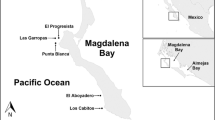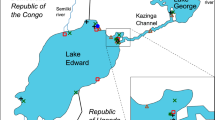Abstract
The ictalurid genus Prietella was described from a single locality in northern México (Coahuila) in 1954, and until very recently went largely unstudied. Cave explorers have recently uncovered new localities and a second species much farther to the south (México: Tamaulipas). Our team visited over 50 sites, including all of the previously known sites possible, and explored many new sites, expanding the known range of Prietella and describing their habitat. We identified geological units and mapped caves, identified associated troglobitic invertebrates, estimated population sizes and measured water chemistry parameters. We also comment on laboratory diet, parasites, sensory biology, behavior (such as jaw locking and periods of inactivity), reproduction and systematics based on preliminary genetic data. Prietella phreatophila is listed as endangered, and due to the recent discovery of many more sites (formerly documented from three localities, now known from twelve sites, though some are hydrologically connected) we recommend threatened status, with careful attention to growing threats such as over pumping and contamination of the aquifer it lives in. Should these patterns continue unchecked, re-listing this species as endangered may be called for. Prietella lundbergi was also described from one site but is now known from two, though it is quite rare at both (only five specimens have ever been seen). P. lundbergi was described after the most recent revision of the Mexican endangered species list and should probably be considered as endangered.
Similar content being viewed by others
References
Amemiya, C.T., S.W. Kelsch, F.S. Hendricks & J.R. Gold. 1986. The karyotype of the Mexican blindcat, Prietella phreatophila Carranza (Ictaluridae). Copeia 1986: 1024–1028.
Axel, W., G. Proudlove, J. Parzefall, H. Wilkens & T.T. Nalbant. 1999. Pisces (Teleostei). pp. 1177–1213. In: C. Juberthie & V. Decu (ed.) Encyclopaedia Biospeologica, Societe de Biospeologia, Moulis-Bucarest.
Bart, H.L. Jr. & M.S. Taylor. 1993. Type specimens of fishes in the Tulane University Museum of Natural History. Tulane Stud. Zool. Bot. 29: 29–72.
Borowsky, R. 1996. The Sierra de El Abra of northeasternMéxico: blind fish in the world's largest cave system. Trop. Fish Hobb. 46: 178–188.
Botosaneanu, L., T.M. Iliffe & D.A. Hendrickson. 1998. On a collection of stygobitic cirolanids (Isopoda: Cirolanidae) from northern México, with description of a new species. Biologie 68: 123–134.
Brune, G. 1981. Springs of Texas. Branch-Smith, Fort Worth. 566 pp.
Carillo-Bravo, J. 1971. La plataformaValles-San Luis Potosí. Bol. Asoc. Mex. Geól. Petr. 23: 1–113.
Carranza, J. 1954. Descripción del primer bagre anoftalmo y depigmentado encontrado en aguas Mexicanas. Ciéncia (México) 14: 129–136.
Cole, G.A. 1984. Crustacea from the Bolsón of Cuatro Ciénegas, Coahuila, México. J. Ariz-Nev. Acad. Sci. 19: 3–12.
Contreras-Balderas, S. & M.L. Lozano-Vilano. 1994. Water, endangered fishes, and development perspectives in arid lands of México. Conserv. Biol. 8: 379–387.
Culver, D.C., L.L. Master, M.C. Christman & H.H. Hobbs, III. 2000. Obligate cave fauna of the 48 contiguous United States. Conserv. Biol. 14: 386–401.
Darnell, R.M. 1962. Fishes of the Rio Tamesí and related coastal lagoons in east-centralMéxico. Publ. Inst. Mar. Sci. Univ.Texas (8): 299–365.
Dasher, G. 1994. On station: a complete handbook for surveying and mapping caves. National Speleological Society, Huntsville. 242 pp.
Exley, S. 1979. ¡Nacimientos! Diving the big springs of the Sierra Madre. Ass. Mex. Cave Stud. Bull. 10: 23–31.
Fish, J.E. 1977. Karst hydrogeology and geomorphology of the Sierra de El Abra and the Valles-San Luis Potosi region, México. Ph.D. Dissertation, McMaster University, Hamilton. 469 pp.
Hershler, R. 1984. The hydrobiid snails (Gastropoda: Rissoacea) of the Cuatro Ciénegas basin: systematic relationships and ecology of a unique fauna. J. Ariz.-Nev. Acad. Sci. 19: 61–76.
Lesser, J.M. & G. Lesser. 1988. Region 9, Sierra Madre Oriental. pp. 89–92. In: W. Back, J.S. Rosenshein & P.R. Seaber (ed.) Hydrogeology (volume O-2), Geological Society of America, Boulder.
Leviton, A.E., R.H.J. Gibbs, E. Heal & C.E. Dawson. 1985. Standards in herpetology and ichthyology: part 1. Standard symbolic codes and institutional resource collections in herpetology and ichthyology. Copeia 1985: 802–832.
Leviton, A.E. & R.H.J. Gibbs. 1988. Standards in herpetology and ichthyology. Standard symbolic codes for institutional resource collections in herpetology and ichthyology. Supplement No. 1: additions and corrections. Copeia 1988: 280–282.
Longley, G. 1981. The Edwards Aquifer: Earth's most diverse groundwater ecosystem? Int. J. Speleol. 11: 123–128.
Lundberg, J.G. 1982. The comparative anatomy of the toothless blindcat, Trogloglanis pattersoni Eigenmann, with a phylogenetic analysis of the ictalurid catfishes. Misc. Publ. Mus. Zool. Univ. Mich. (163): 1–83.
Lundberg, J.G. 1992. The phylogeny of ictalurid catfishes: a synthesis of recent work. pp. 392–420. In: R. L. Mayden (ed.) Systematics, Historical Ecology, and North American Freshwater Fishes, Stanford University Press, Stanford.
Minckley, W.L. 1969. Environments of the Bolsón of Cuatro Ciénegas, Coahuila, México. Science Series, University of Texas, El Paso, Texas (2): 1–65.
Mitchell, R.W., W.H. Russell & W.R. Elliott. 1977. Mexican eyeless characin fishes of the genus Astyanax: environment, distribution and evolution. Mus. Tex. Tech Univ. Sp. Publ. (12): 1–89.
Nelson, J.E. 1994. Fishes of theworld. John Wiley and Sons, New York. 600 pp.
Padgett, A. & B. Smith. 1987. On rope: North American vertical rope techniques. National Speleological Society, Huntsville. 341 pp.
Prosser, J. & H.V. Grey. 1992. NSS cave diving manual. The Cave Diving Section of the National Speleological Society, Branford. 377 pp.
Prentice, J.A. & P. Thomas. 1987. Successful spawning of orangemouth corvina following injection with des-Gly10, [d-Ala6]-Luteinizing hormone-releasing hormone (1–9) Ethylamide and Pimozide. Prog. Fish-Cult. 49: 66–69.
Reddell, J.R. 1981. A review of the cavernicole fauna ofMéxico, Guatemala, and Belize. Bull. Tex. Mem. Mus. (27): 1–327.
Reddell, J.R. 1994. The cave fauna of Texas, with special reference to the western Edwards Plateau. pp. 31–49. In: W.R. Elliott & G. Veni (ed.) The Caves and Karst of Texas, National Speleological Society, Huntsville. 342 pp.
Russell, W.H. & T.W. Raines. 1967. Caves of the Inter-American highway, Nuevo Laredo, Tamaulipas to Tamazunchale, San Luis Potosi. Ass. Mex. Cave Stud. Bull. (1): 1–126.
Secretaría de Desarrollo Social. 1994. Norma Oficial Mexicana NOM-059-ECOL-1994, que determina las especies y subespecies de flora y fauna silvestres y acuáticas en peligro de extinción, amenazadas, raras y sujetas a protección especial, y que establece especificaciones para su protección. Diario Oficial De La Federación, México 488(10): 2–60.
Smith, A.R. & G. Veni, 1994. Karst regions of Texas. pp. 7-12. In: W.R. Elliott & G. Veni (ed.) The Caves and Karst of Texas, National Speleological Society, Huntsville.
Villalobos, J.L., F. Alvarez & T.M. Iliffe. 1999. New species of troglobitic shrimps from M´exico, with the description of Troglomexicanus, new genus (Decapoda: Palaemonidae). J. Crust. Biol. 19: 111–112.
Walsh, S.J. 2000. Conservation of aquatic karst biotas: shedding light on troubled waters. pp. 106–108. In: R.A. Abell, D.M. Olson, E. Dinerstein, P.T. Hurley, J.T. Diggs, W. Eichbaum, S. Walters, W. Wetengel, T. Allnutt, C.J. Loucks & P. Hedao (ed.) Freshwater Ecoregions of North America:A Conservation Assessment, Island Press, Washington, D.C.
Williams, J.E., J. Johnson, D.A. Hendrickson, S. Contreras-Balderas, J.D. Williams, M. Navarro-Mendoza, D.E. McAllister & J.E. Deacon. 1989. Fishes of North America endangered, threatened or of special concern: 1989. Fisheries 14: 2–20.
Author information
Authors and Affiliations
Rights and permissions
About this article
Cite this article
Hendrickson, D.A., Krejca, J.K. & Martinez, J.M.R. Mexican Blindcats Genus Prietella (Siluriformes: Ictaluridae): an overview of Recent Explorations. Environmental Biology of Fishes 62, 315–337 (2001). https://doi.org/10.1023/A:1011808805094
Issue Date:
DOI: https://doi.org/10.1023/A:1011808805094




